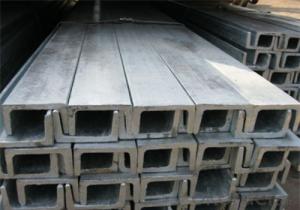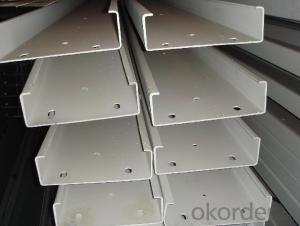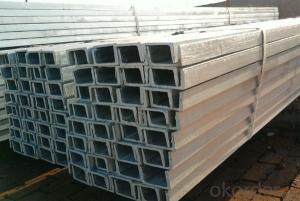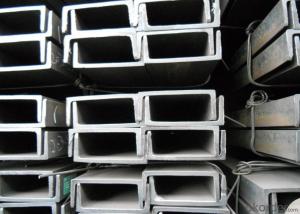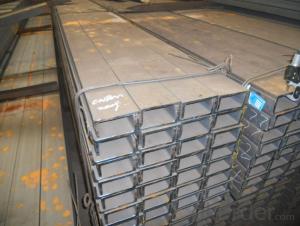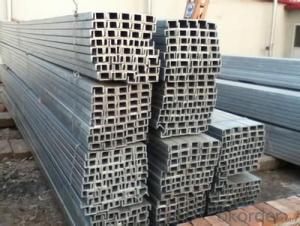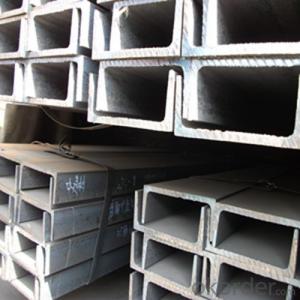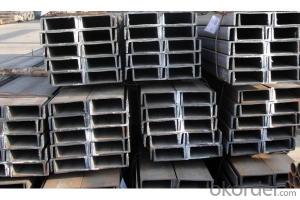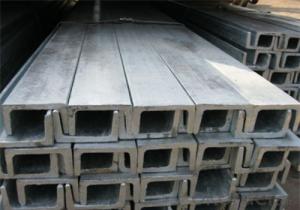U Channel Beam Channel Iron Sizes Steel
- Loading Port:
- Tianjin
- Payment Terms:
- TT or LC
- Min Order Qty:
- 28 m.t.
- Supply Capability:
- 40000 m.t./month
OKorder Service Pledge
OKorder Financial Service
You Might Also Like
Product Description:
OKorder is offering U Channel Beam Channel Iron Sizes Steel at great prices with worldwide shipping. Our supplier is a world-class manufacturer of steel, with our products utilized the world over. OKorder annually supplies products to European, North American and Asian markets. We provide quotations within 24 hours of receiving an inquiry and guarantee competitive prices.
Product Applications:
U Channel Beam Channel Iron Sizes Steel are ideal for structural applications and are widely used in the construction of buildings and bridges, and the manufacturing, petrochemical, and transportation industries.
Product Advantages:
OKorder's U Channel Beam Channel Iron Sizes Steel are durable, strong, and resist corrosion.
Main Product Features:
· Premium quality
· Prompt delivery & seaworthy packing (30 days after receiving deposit)
· Corrosion resistance
· Can be recycled and reused
· Mill test certification
· Professional Service
· Competitive pricing
Product Specifications:
channel iron sizes steel u channel beam
1.Specification: from 5# to 30#
2.Size 50*37 to 300*89
3.Material:Q235 SS400 Q345
| U CHANNEL BEAMS(JIS) | ||||
| MATERIAL:Q235/SS400/ST37-2 and Q345/ST52 | ||||
| Size | Size/mm | Theoretical Weight | ||
| h | b | d | kg/m | |
| 75*40*3.8 | 75 | 40 | 3.8 | 5.3 |
| 75*40*4.0 | 75 | 40 | 4 | 5.6 |
| 75*40*4.5 | 75 | 40 | 4.5 | 5.85 |
| 75*40*5.0 | 75 | 40 | 5 | 6.92 |
| 100*50*3.8 | 100 | 50 | 3.8 | 7.3 |
| 100*50*4.2 | 100 | 50 | 4.2 | 8.03 |
| 100*50*4.5 | 100 | 50 | 4.5 | 8.97 |
| 100*50*5 | 100 | 50 | 5 | 9.36 |
| 125*65*5.2 | 125 | 65 | 5.2 | 11.66 |
| 125*65*5.3 | 125 | 65 | 5.3 | 12.17 |
| 125*65*5.5 | 125 | 65 | 5.5 | 12.91 |
| 125*65*6 | 125 | 65 | 6 | 13.4 |
| 125*65*5.5 | 150 | 75 | 5.5 | 14.66 |
| 150*75*5.7 | 150 | 75 | 5.7 | 16.71 |
| 150*75*6 | 150 | 75 | 6 | 17.9 |
| 150*75*6.5 | 150 | 75 | 6.5 | 18.6 |
| U CHANNEL BEAMS(CHINESE STANDARD) | ||||
| MATERIAL:Q235/SS400/ST37-2 and Q345/ST52 | ||||
| Size | Size/mm | Theoretical Weight | ||
| h | b | d | kg/m | |
| 5 | 50 | 37 | 4.5 | 5.438 |
| 6.3 | 63 | 40 | 4.8 | 6.634 |
| 8 | 80 | 43 | 5 | 8.045 |
| 10 | 100 | 48 | 5.3 | 10.007 |
| 12.6 | 126 | 53 | 5.5 | 12.318 |
| 14a | 140 | 58 | 6 | 14.535 |
| 14b | 140 | 60 | 8 | 16.733 |
| 16a | 160 | 63 | 6.5 | 17.24 |
| 16 | 160 | 65 | 8.5 | 19.752 |
| 18a | 180 | 68 | 7 | 20.174 |
| 18 | 180 | 70 | 9 | 23 |
| 20a | 200 | 73 | 7 | 22.637 |
| 20 | 200 | 75 | 9 | 25.777 |
| 22a | 220 | 77 | 7 | 24.999 |
| 22 | 220 | 79 | 9 | 28.453 |
| 25a | 250 | 78 | 7 | 27.41 |
| 25b | 250 | 80 | 9 | 31.335 |
| 25c | 250 | 82 | 11 | 35.26 |
| 28a | 280 | 82 | 7.5 | 31.427 |
| 28b | 280 | 84 | 9.5 | 35.823 |
| 28c | 280 | 86 | 11.5 | 40.219 |
| 30a | 300 | 85 | 7.5 | 34.463 |
| 30b | 300 | 87 | 9.5 | 39.173 |
| 30c | 300 | 89 | 11.5 | 43.833 |
| 32a | 320 | 88 | 8 | 38.083 |
| 32b | 320 | 90 | 10 | 43.107 |
| 32c | 320 | 92 | 12 | 48.131 |
| 36a | 360 | 96 | 9 | 41.814 |
| 36b | 360 | 98 | 11 | 53.466 |
| 36c | 360 | 100 | 13 | 59.928 |
| 40a | 400 | 100 | 10.5 | 58.928 |
| 40b | 400 | 102 | 12.5 | 65.208 |
| 40c | 400 | 104 | 14.5 | 71.488 |
FAQ:
Q1: Why buy Materials & Equipment from OKorder.com?
A1: All products offered byOKorder.com are carefully selected from China's most reliable manufacturing enterprises. Through its ISO certifications, OKorder.com adheres to the highest standards and a commitment to supply chain safety and customer satisfaction.
Q2: How do we guarantee the quality of our products?
A2: We have established an advanced quality management system which conducts strict quality tests at every step, from raw materials to the final product. At the same time, we provide extensive follow-up service assurances as required.
Q3: How soon can we receive the product after purchase?
A3: Within three days of placing an order, we will begin production. The specific shipping date is dependent upon international and government factors, but is typically 7 to 10 workdays.
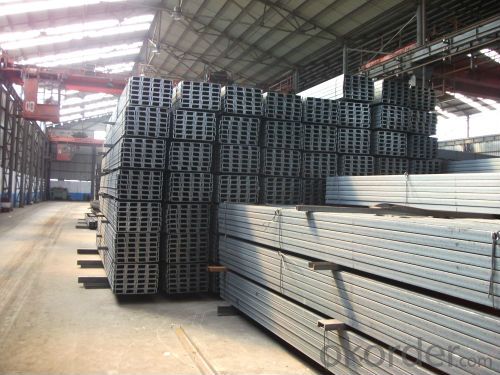
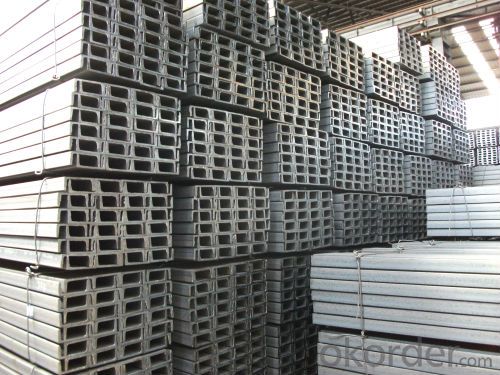
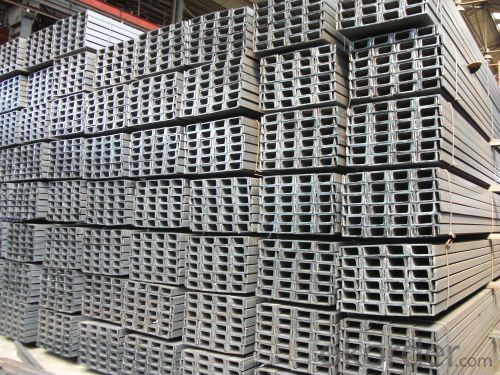
- Q: What are the different methods for reinforcing steel channels?
- There are several methods for reinforcing steel channels, depending on the specific requirements and applications. Some of the common methods include: 1. Welding: Welding is a widely used method for reinforcing steel channels. It involves attaching additional steel plates or bars to the existing channel using high heat generated by an electric arc. This method provides a strong bond and ensures structural integrity. 2. Bolting: Bolting is another method used to reinforce steel channels. It involves attaching additional steel plates or bars to the channel using bolts and nuts. This method is relatively easier to implement and allows for easy removal or adjustment if required. 3. Adhesive bonding: Adhesive bonding is a technique that involves using industrial-grade adhesives to bond additional steel plates or bars to the steel channel. This method offers a strong bond and is often used in applications where welding or bolting may not be feasible or desired. 4. Fiber reinforced polymers (FRP): FRP composites, such as carbon fiber or fiberglass, can be used to reinforce steel channels. These materials are lightweight, high-strength, and corrosion-resistant, making them ideal for strengthening channels in corrosive environments or where weight is a concern. 5. Shotcreting: Shotcreting is a method that involves spraying a mixture of cement, sand, and reinforcing fibers onto the surface of the steel channel. This creates a layer of reinforced concrete that enhances the strength and durability of the channel. 6. Encasement: In some cases, steel channels may be reinforced by encasing them in concrete. This method involves pouring concrete around the channel, creating a composite structure that combines the strength of both materials. 7. Pre-stressing: Pre-stressing is a technique that involves applying tension to the steel channel before it is loaded. This can be done using pre-stressed steel strands or bars, which are anchored at the ends of the channel. The pre-stressing force helps to counteract the tensile forces that the channel may experience during use. It is important to note that the selection of the appropriate method for reinforcing steel channels depends on factors such as the load requirements, environmental conditions, cost, and feasibility. Consulting with a structural engineer or expert is recommended to ensure the chosen method meets the specific needs of the application.
- Q: Are steel channels suitable for corrosive environments?
- No, steel channels are not suitable for corrosive environments as they are prone to rust and deterioration when exposed to corrosive elements.
- Q: What kind of high strength steel and square steel
- Of course, the same thickness 6 high strength.
- Q: What type of channel steel and I-beam should be used to build an attic floor? Thank you!
- 4.5 meters wide, certainly not wooden side. If you use wood, you will regret it in the future. 4.5 meters wide with wooden square, unless there is an upright post in the middle, otherwise it will surely fall. This is not a ceiling. If you use wood, you can only use more than 20 cm of raw wood through. I used to do an attic, the width of the room is 3.6 meters, all of the diameter of about 20 of the original wood, and later used basically do not shake, you can have this room nearly 1 meters wide oh.
- Q: Can steel channels be used in the renewable energy parts manufacturing industry?
- Yes, steel channels can be used in the renewable energy parts manufacturing industry. Steel channels are versatile and can be utilized in various applications, including the production of renewable energy equipment such as solar panels, wind turbines, and hydropower systems. The strength, durability, and cost-effectiveness of steel make it a suitable choice for constructing and supporting renewable energy infrastructure.
- Q: How do steel channels contribute to acoustic performance?
- Various applications can benefit significantly from the use of steel channels to improve acoustic performance. One of the main advantages of steel channels is their ability to minimize sound transmission and enhance sound insulation. When incorporated into wall or ceiling systems, steel channels act as a barrier that prevents sound from traveling between different spaces. The design and construction of steel channels allow for the installation of sound insulation materials, such as mineral wool or acoustic foam. These materials effectively absorb and dampen sound waves, reducing the transmission of noise from one area to another. By integrating steel channels into the construction of walls or ceilings, the overall acoustic performance of a space can be greatly enhanced. Steel channels not only excel in sound insulation but also contribute to the improvement of room acoustics. For instance, by utilizing steel channels to create a suspended ceiling, a more balanced and controlled sound environment can be achieved. The space between the steel channels can be filled with acoustic tiles or panels, which absorb sound reflections and minimize echoes, resulting in better speech intelligibility and overall sound quality. Furthermore, steel channels can also be utilized to support the installation of sound-absorbing materials on walls or ceilings. Materials such as fabric-wrapped panels or perforated metal sheets help reduce reverberation and echo in a room, thereby enhancing its acoustic performance. Steel channels provide a reliable framework to securely mount these materials, ensuring their effectiveness in enhancing sound absorption. In summary, steel channels contribute to acoustic performance by reducing sound transmission, improving sound insulation, and enhancing room acoustics. Whether used in the construction of walls, ceilings, or as a support for sound-absorbing materials, steel channels play a pivotal role in creating a more acoustically favorable environment, be it in residential, commercial, or industrial settings.
- Q: How do steel channels perform in extreme temperature conditions?
- Steel channels generally perform well in extreme temperature conditions. Steel has a high melting point and excellent thermal conductivity, allowing it to withstand both high and low temperatures without significant structural changes. However, it is important to consider the specific alloy and grade of steel used, as some may have limitations in extreme temperature environments. Additionally, factors such as thermal expansion and contraction should be accounted for in the design and installation process to ensure optimal performance.
- Q: How do steel channels contribute to sustainable design in buildings?
- Steel channels play a crucial role in promoting sustainable design in buildings due to their numerous advantages in terms of durability, recyclability, and energy efficiency. Firstly, steel channels are known for their exceptional durability, which contributes to the longevity of buildings. Unlike other materials, steel channels have a high resistance to corrosion, weathering, and pests. This durability reduces the need for frequent maintenance and replacement, leading to a decrease in the overall environmental impact of the building. Secondly, steel channels are highly recyclable. At the end of a building's life cycle, steel channels can be easily dismantled and recycled, ensuring that they do not end up in landfills. This recycling process requires significantly less energy compared to the production of new steel, resulting in reduced carbon emissions and conservation of natural resources. Furthermore, steel channels enable energy-efficient designs in buildings. Due to their high strength-to-weight ratio, steel channels allow for the construction of lighter structures, reducing the amount of material required. This, in turn, leads to a decrease in energy consumption during construction and transportation. Additionally, steel channels can be easily integrated with insulation systems, improving the building's thermal performance and reducing the need for excessive heating or cooling. Moreover, steel channels can be prefabricated off-site, minimizing construction waste and improving productivity through precise manufacturing. This process reduces the environmental impact of construction activities, such as noise, dust, and energy consumption. Lastly, steel channels provide design flexibility, allowing architects and engineers to create innovative and sustainable structures. Their versatile nature allows for the implementation of various design techniques, such as modular construction and adaptive reuse. These strategies contribute to sustainable development by optimizing space, reducing material waste, and promoting resource efficiency. In conclusion, steel channels are an essential component of sustainable design in buildings. Their durability, recyclability, energy efficiency, and design flexibility contribute to the reduction of environmental impact, conservation of resources, and promotion of sustainable practices in the construction industry.
- Q: What are the different methods of rust prevention for steel channels?
- Steel channels can be protected from rust through various methods. Here are some commonly used ones: 1. Galvanization: Coating the steel channels with zinc is a widely employed technique. Zinc acts as a sacrificial anode, safeguarding the steel from corrosion. Depending on the specific requirements, galvanization can be achieved through hot-dip galvanizing or electro-galvanizing. 2. Application of Paint or Powder Coating: By applying paint or powder coating, a protective barrier is created between the steel channels and the environment. This prevents moisture and oxygen from reaching the steel surface, effectively inhibiting rust formation. It is crucial to carry out proper surface preparation and use high-quality anti-corrosion paints for effective coating. 3. Epoxy Coating: Epoxy coatings offer excellent rust and corrosion protection. These coatings consist of a resin and a hardener, applied as a two-part system. Epoxy coatings are renowned for their durability, chemical resistance, and strong adhesion to steel surfaces. 4. Cathodic Protection: This method involves the use of sacrificial anodes or impressed current to shield steel channels from rust. Sacrificial anodes, usually made of zinc or aluminum, are connected to the channels and corrode instead of the channels. Impressed current systems employ an external power supply to generate a protective electric current that prevents corrosion. 5. Rust Inhibitors: Chemical compounds known as rust inhibitors can be applied to the steel channels to hinder rust formation. These inhibitors create a protective layer on the metal surface, preventing moisture and oxygen from reaching the steel. They can be applied as a spray, dip, or incorporated into coatings or paints. Choosing the appropriate rust prevention method depends on the specific application, environmental conditions, and budget constraints. Regular maintenance and inspection of the steel channels are vital to promptly identify and address any signs of rust or corrosion.
- Q: Can steel channels be used for railway tracks?
- No, steel channels are not suitable for railway tracks. Railway tracks require specific rail profiles that are designed to withstand the weight and movement of trains, and to provide stability and durability over long distances. Steel channels lack the necessary properties and dimensions required for railway tracks.
Send your message to us
U Channel Beam Channel Iron Sizes Steel
- Loading Port:
- Tianjin
- Payment Terms:
- TT or LC
- Min Order Qty:
- 28 m.t.
- Supply Capability:
- 40000 m.t./month
OKorder Service Pledge
OKorder Financial Service
Similar products
Hot products
Hot Searches
Related keywords
